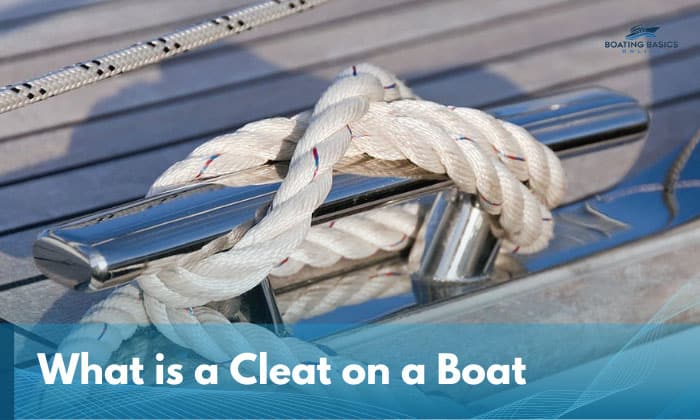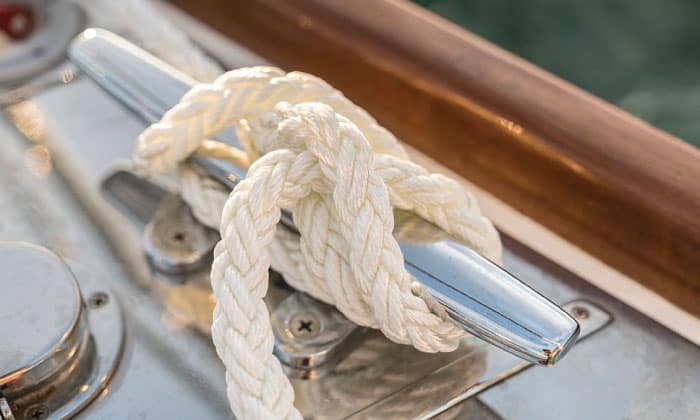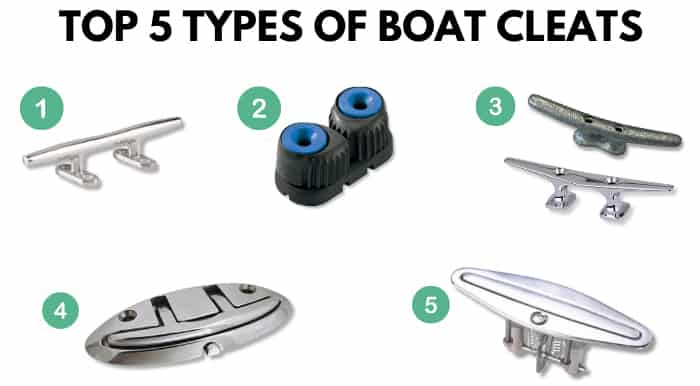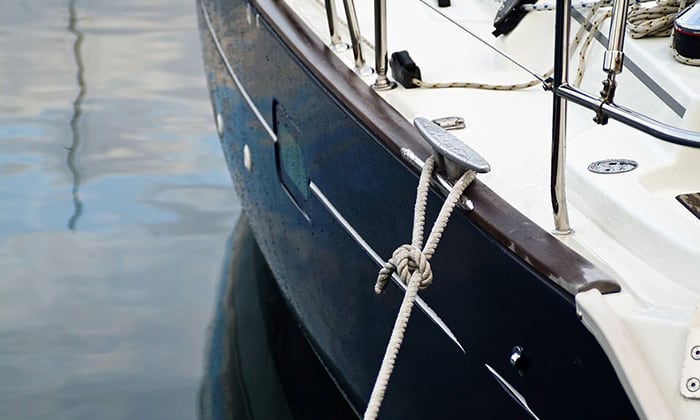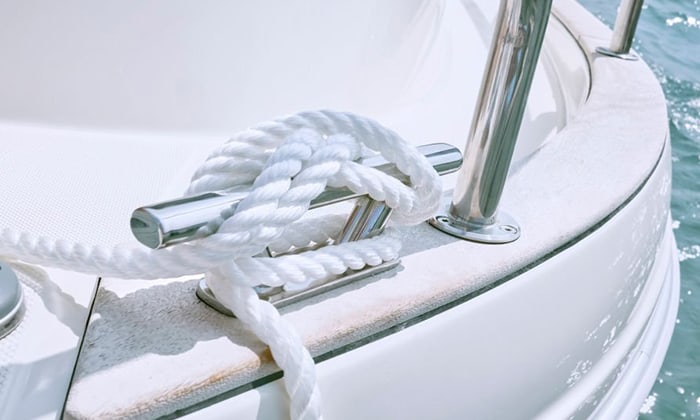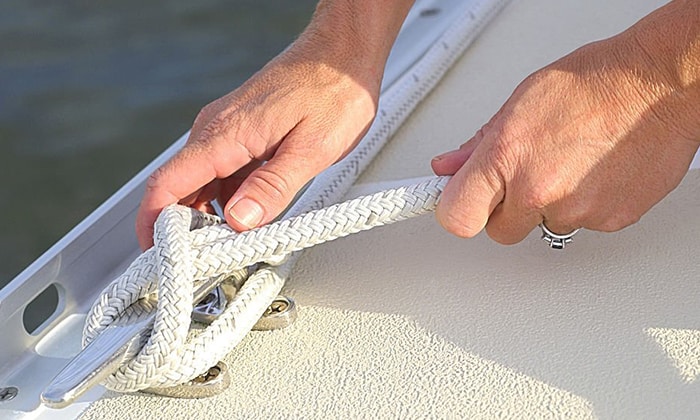With the number of boating fittings any vessel may have, it’s easy to get lost figuring out the function of each one. “What is a cleat on a boat?” is but one of the many questions first-time boat owners or simple boating enthusiasts ask.
A boat cleat is a fixture used to secure lines of rope on the vessel itself. Mounted on the gunwale, its horns serve as tying-off points for the lines. Variations allow it to fulfill more than one purpose.
Table of Contents
- Overview of a Cleat on a Boat
- Importance of Boat Cleats
- Different Types of Boat Cleats
- Common Usage Scenarios
- Cleat Materials
- Explaining Boat Cleat Functionality
- Placement and Installation of Cleats
- Maintenance and Care for Cleats
- How to Choose the Right Boat Cleats?
- Cleat Accessories and Additional Considerations
- Frequently Asked Questions
- Conclusion
Overview of a Cleat on a Boat
Boat cleats are highly practical implements that allow you to have a sturdy point from which you can tie vital lines of ropes. This is so you can have optimal line management and mooring, which is a more secure way to dock as it involves tying your vessel to it.
Where is the cleat on a boat? Boat builders typically mount boat cleats on the upper sides of the vessels (aka the gunwale) with a specified distance and interval.
Incidentally, cleats on boats should not be confused with a dock cleat, which is attached to a dock or marina. It serves the same purpose as a horn cleat on a boat, though.
Importance of Boat Cleats
Based on the definition, we can already see why installing cleats is a must. To further add to that, I’ve gone ahead and listed down every advantage:
- They’re specifically designed to keep your boat from drifting off while docked.
- They provide the necessary tensile strength, especially those made from stainless steel, that can handle continuous pressure, which may result from changing weather and water conditions while moored.
- They help to manage your lines easier, whether they’re dock lines, fender lines, or anchor lines.
- Their configuration makes it easier to adjust their lines’ tension and quickly untie and tie knots when necessary.
- You never know when you’ll need a safe point from which to tie a strong line of rope during emergency situations.
Different Types of Boat Cleats
The following are the different types of boat cleats with their distinct designs and characteristics.
1. Horn Cleat
The classical cleat is characterized by its two horns either protruding straightly from side to side or curing a bit upward.
2. Cam and Clam Cleat
Both are cleats mainly used to control the sails of sailboats. Cam cleats rely on a spring-loaded cam mechanism for gripping and releasing in seconds, while the latter uses jaws with a firmer grip.
3. Open Base and Closed Base Cleat
These are differentiated by the presence (open base) or absence (closed base) of an opening on the cleat’s base. Either one usually determines the knot you should use and how sleek and neat it would look.
4. Folding Cleats
These are usually designed as open-base cleats that you can lock down or retract if you don’t need them. Some designs allow you to re-engage the cleat by simply pushing a button.
5. Pop-up Cleats
These are similar to folding cleats, but you have to push them down to retract them instead. A locking mechanism will engage to keep them in place. The pop-up is also triggered by a button.
Common Usage Scenarios
Here are a few situations where the boat cleats are extremely handy:
- For securing vessels of various sizes to the dock.
- In the context of sailboats, cleats play a much more crucial role in helping the operator control their sails. For example, with a clam cleat, they can freely adjust their forestays’ tension, and it’s also equipped with a jaw that keeps the line securely in place.
- Powerboat owners love to modernize their vessels by installing pop-up cleats, which not only provide a sleeker, cleaner look but heighten safety as well. After all, traditional horn cleats can be quite the tripping hazard and may cause ropes to be entangled or snagged.
Cleat Materials
There are a number of materials modern-day boat cleats are made of.
- Nylon
Plastic-based cleats tend to be cheaper, don’t rust, and are naturally resistant to corrosion and the elements. The downside is that they may not be as sturdy as metal cleats.
- Aluminum
Preferred for its lightweight, aluminum is also highly resistant to corrosion, ideal for lighter boats and loads, and can last a lifetime.
- Chrome-plated Zinc
The chrome plating adds to overall wear and tear resistance while canceling its brittleness by using zinc, which has high strength, as its base metal.
- Stainless Steel
According to tests, stainless steel cleats have been found to withstand the most load, making them the most recommended for sturdiness. Added bonuses include the ability to withstand harsh marine conditions, excellent corrosion resistance, and superb strength.
- Bronze
Highly resistant to corrosion, bronze also imparts a unique aesthetic touch that fits a boat with a more classic motif.
- Marinium
Made of an alloy composed of aluminum, magnesium, titanium, beryllium, and certain other metals, marinium cleats have been found to be second only to stainless steel cleats in bearing the most load and total tensile strength. It also doesn’t tarnish easily.
Explaining Boat Cleat Functionality
How to use a cleat? Given its purpose of solely securing lines, using this tool is mostly about learning how to properly tie the boat to the cleat and the dock.
There are a number of knots worth knowing, but one that’s worth knowing by any boat operator is a basic but ever-reliable cleat knot called a Cleat Hitch.
It works well with a closed-base cleat and is fairly easy to master. Here’s a video demo of how to do it:
It results in a secure knot that can keep any boat properly moored for a long time. You can also use an even more secure knot called the Figure 8 Cleat Hitch, as shown in this video:
How Does a Cleat Work?
Once a line has been securely tied, the cleat works by being a fixture that holds the rope in place. It creates the right tension that prevents the rope from coming loose.
The horns on a horn cleat are designed as such so that they’ll be able to provide a secure hold or anchoring point, even if you don’t tie a rope in a knot around them.
Pros and cons
- Helps to keep you and your watercraft secure
- Adds a stylish touch to your boat
- Requires minimal to no maintenance once installed
- Easy to get the hang of
- Some cleats may not offer enough adjustability
- May fail at certain loads depending on material and installation
Placement and Installation of Cleats
Choosing Cleat Placement
Cleat placement is important to make sure that it can effectively handle the lines attached to it. Here are the most important factors to consider when deciding boat cleat placement:
- There should be a set interval in the distance of the cleats on both sides of the boat.
- Although at least three cleats on both the port and starboard will do, it doesn’t hurt to have more for better flexibility.
Proper Installation Techniques
It’s always best to follow the manufacturer’s instructions when installing any cleat hook for your boat. Here are some general tips apply to make sure the cleat will stay in place and optimally fulfill its functionality:
- Assuming there’s adequate access, consider back-plating the cleats. You can attach a solid board behind the mounting area to distribute the load and boost durability.
- Reinforce the plates using bolts, then pair them with nuts and washers to prevent them from coming loose. This will boost its strength.
- Be mindful of holes you create for access. Ensure a water-tight installation by using pie plates to cover them.
Maintenance and Care for Cleats
Cleaning and Polishing
- Flitz has been recommended to me by other boaters and works exceptionally as an all-around cleaner for rust protection.
- Most metal cleaners and polishes are straightforward to apply. Just don’t go overboard and use only as much as necessary.
Common Issues and Troubleshooting Tips
- Rusting
Stainless steel cleats are subject to rusting. Once you encounter this issue, you can use proven products like Bon Ami or other rust removers available to you.
- Getting ripped out or coming loose
Crazy storms and a janky installation often result in this problem. There’s no other way around it than to ensure you’re correctly installing your cleats and doing everything possible so that they’re firmly in place.
- Line jamming
This may happen if you use the wrong knot and the load ends up getting jammed. This could spell trouble, as you essentially no longer have control over the line.
How to Choose the Right Boat Cleats?
Choosing the right boat cleats is essential for ensuring secure mooring and docking of your boat. Here are some tips to help you choose the perfect boat cleats:
- Boat Size and Type: This dictates the size and strength of the cleats you need. Larger boats or those subjected to heavier loads will require more robust cleats than smaller vessels.
- Determine the Material: Boat cleats can be made of various materials. Scroll up to find the material that best suits your needs and preferences.
- Cleat Design: Cleats come in various designs, and each has its strength. Horn cleats are popular for versatility, flat-tops reduce the risk of tripping hazards and folding cleats can be folded down when not in use to create an unobtrusive deck surface.
- Number of Cleats: Determine the number of cleats you need. We recommend installing multiple cleats distributed evenly on both sides of the boat to achieve optimal balance and secure attachment points.
- Installation Considerations: Some cleats require through-bolting, while others can be secured with screws or specific mounting systems. Choose the one compatible with your boat’s deck or hull structure.
- Quality and Durability: Go for the best-quality cleats within your budget. The marine environment is harsh. Having durable cleats and accessories means less maintenance and more aquatic fun.
If you still struggle finding cleats suitable for your boat, consult an expert. Ask marine professionals, boat dealers, or experienced boaters for guidance.
Cleat Accessories and Additional Considerations
- Consider cleat covers to protect you and your passengers from possible cleat-based injuries while onboard.
- Extenders can boost the line accessibility and flexibility of every cleat.
Frequently Asked Questions
How do I know the right size of cleats for my boat?
It depends on the boat’s size and the line’s size. You don’t need a size chart to determine which one to use. Just follow this guideline:
- Increase your cleat length by 1 inch for every 1/16-inch diameter of line and ⅛-inch diameter for every 9 feet of boat length.
Are there any safety considerations when using boat cleats?
Improperly used and if issues arise, they may cause injury and even death of passengers directly and indirectly. Always beware of sharp edges, use the proper knots, and make sure there’s still ample space for movement once your lines are up.
Can boat cleats be used for purposes other than docking?
Yes, besides rigging sailboats and mooring, they can also be used for towing, anchoring, and for managing fenders.
Conclusion
Considering everything there is to know with regard to what is a cleat on a boat, it’s safe to say that it’s every boater’s best friend. We all want to keep our prized vessels free from damage and safe in their respective slips.
It’s hard to imagine making that possible without this simple yet versatile device. The fact that it’s this flexible and comes in various materials, types, and sizes only proves that point.

“My intention from the first day establishing Boating Basics Online is to provide as much help as possible for boaters who want to experience a first safe and convenient trip. So feel free to join us and share your beautiful journeys to the sea!”

